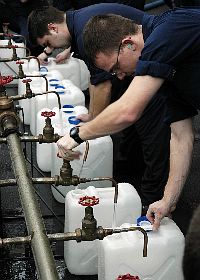 |
| Disaster Relief Efforts |
January 04, 2005 |
| |
How You Can Help
 PHOTO: USS Bonhomme Richard has airlifted 200,000 pounds of disaster relief supplies. PHOTO: USS Bonhomme Richard has airlifted 200,000 pounds of disaster relief supplies.
Government officials are advising Americans wishing to offer support in the relief effort to make cash donations instead of used clothing, canned goods or other items. All assistance is greatly appreciated, but cash donations are the most helpful form of assistance for tsunami victims for these reasons:

Cash is the fastest and most direct way to get assistance to specific affected areas. Choose non-governmental and charitable organizations that are established and respected in the disaster response field.
The cost of shipping other goods often exceeds the value of the goods themselves or the items may not be appropriate or timely in their arrival.
Cash will also be used for the purchase of goods on the ground in the affected areas in order to help the local economies, which were so severely impacted by the tsunami.
People in Need
On December 26, a magnitude 9.0 earthquake, off the west coast of Northern Sumatra, Indonesia, triggered massive tsunamis that affected several countries throughout South and Southeast Asia, as well as Somalia, Tanzania, and Kenya in East Africa.

PHOTO: Sailors from the USS Abraham Lincoln work to provide purified water for disaster victims.
Aftershocks from the earthquake continued to occur in the region through January 1, when a magnitude 6.5 earthquake occurred off the west coast of Northern Sumatra.
The estimated death toll from the December 26 earthquake and tsunamis could be more than 150,000 people in South and Southeast Asia and East Africa.
It is estimated that between 3 and 5 million people are lacking basic survival requirements—access to clean water, adequate shelter, food, sanitation and health care.
Contaminated water sources have increased the risk of cholera, dysentery, malaria, and dengue fever.
Approximately 500,000 people are displaced in Indonesia; more than 889,175 are displaced in Sri Lanka; 3.5 million people are affected in India; and more than 10,000 are injured in Thailand. In addition, between 15,000 and 30,000 may be affected in Somalia; 12,000 are displaced in Malaysia; and approximately 12,000 are displaced and 300,000 affected in the Maldives.
America Responds
On December 31, President Bush pledged $350 million in relief and recovery assistance, bringing the total amount of pledges from donor countries and the World Bank to an estimated $2 billion.
PHOTO: Disaster relief efforts are detailed. Click photo to read more.
The U.S. is leading a core group of nations to help with immediate humanitarian relief, rehabilitation, and long-term reconstruction efforts, including India, Japan, and Australia.
On January 2, U.S. Secretary of State Colin Powell led a delegation of U.S. officials including Florida Governor Jeb Bush to visit the disaster-stricken areas of Asia.
The U.S. Pacific Command said this week it is deploying 20 ships from docks in Hong Kong, Guam and the island of Diego Garcia.
The ships are loaded with medical equipment and mobile hospitals, 41 helicopters, 2,100 Marines, 1,400 sailors and the capacity to generate 600,000 gallons of fresh water daily.
On December 27th, the U.S. provided more than 3,000 metric tons of rice to the U.N. World Food Program for use in the affected region.
The Department of Defense and USAID have established regional coordination centers in Bangkok, Thailand and Colombo, Sri Lanka. These centers will help coordinate the massive U.S. relief efforts.
In addition to the hundreds of U.S. Embassy and USAID Mission staff who are now dedicated to the response to this disaster in their respective countries, USAID’s Disaster Assistance Response Team (DART) members and other U.S. assistance team member are already on the ground and/or moving into the affected countries.
www.USAID.gov
www.USAFreedomCorps.gov |
|
|
 |